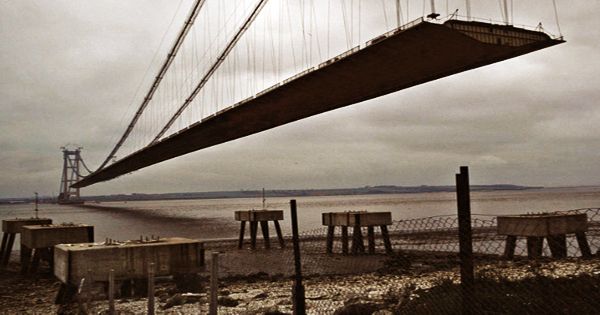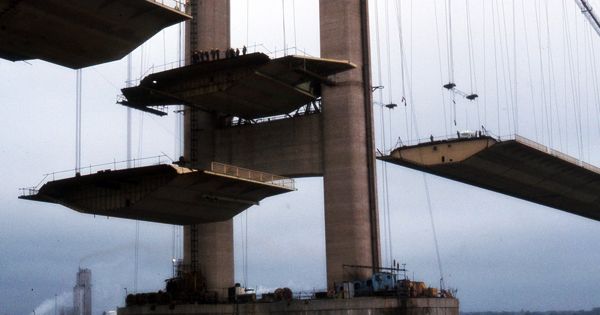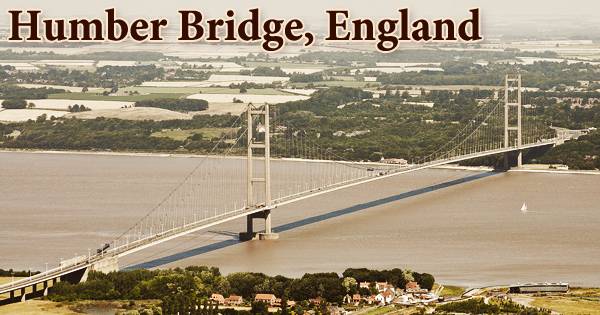With a span of 1,410 meters, the Humber Bridge is the world’s eighth-largest suspension bridge. It is situated between the Lincolnshire towns of Barton-upon-Humber and Hessle in the East Riding of Yorkshire in England. It is a single-span, 2.22 km (2,430 yd; 7,300 ft; 1.38 mi) road suspension bridge that opened to traffic on June 24, 1981. When it first opened, the bridge was the world’s longest of its kind; it wasn’t surpassed until 1998 when the Akashi Kaiky Bridge was completed, and it is now the eleventh-longest. The bridge has two lanes of traffic in each direction, as well as a pedestrian path on both sides. In the 1930s, there was a proposal to construct a bridge across the strait. The bridge’s construction began in 1972. Queen Elizabeth II formally opened the bridge in 1981.
The bridge connects the East Riding of Yorkshire and North Lincolnshire by crossing the Humber (an estuary created by the rivers Trent and Ouse) between Barton-upon-Humber on the south bank and Hessle on the north bank. Until its dissolution in 1996, both sides of the bridge were in the non-metropolitan county of Humberside. Before the Akashi-Kaikyo Bridge in Japan opened in 1998, the Humber Bridge was the world’s largest suspension bridge. It has a total length of 7,283 feet and a main span of 4,626 feet (1,410 meters), making it one of the world’s longest bridges (2,220 meters). The main span is held in place by towers that rise 500 feet (152 meters) above the piers that support it.

With the passage of the Humber Bridge Act and the establishment of the Humber Bridge Board in 1959, approval for the construction of a suspension bridge was given, but work did not begin until 1972. There were two reasons why a suspension bridge was chosen. For starters, the Humber Estuary’s bed is constantly moving, and the navigable channel through which ships can navigate is constantly changing. As a result, a suspension bridge in the middle of the estuary with no support piers will not block the waterway. Second, the cost of building a tunnel would have been prohibitively expensive due to the geology and topography of the region.
From as far as Patrington in the East Riding of Yorkshire and out to sea miles off the coast, the bridge can be seen for miles. It’s a Grade I listed structure. Despite the controversy surrounding its construction, the bridge has become a common driving path. By 2006, it was transporting about 120,000 vehicles a week. The bridge has cut the gap between Hull and Grimsby by nearly 50 miles (80km), reducing travel times in the region. Despite the fact that the bridge is currently in debt, owing taxpayers over £150 million, it is credited with helping the local economy.
The construction took eight years to complete, with upwards of a thousand employees on hand at times of peak production. The bridge opened to traffic on June 24, 1981, and Her Majesty the Queen held the formal opening ceremony on July 17, 1981. The Bridge gave the Humber area a chance to realize its economic and industrial growth potential. Commuters used to cross the Humber on the Humber Ferry, which ran between Corporation Pier in Hull and New Holland Pier in New Holland, Lincolnshire, or by rail, crossing the River Ouse near Goole (connected to the Humber) via the M62 (from 1976), M18 (from 1979), and M180 motorways. Bridge plans were drawn up in the 1930s and updated in 1955, but construction did not begin until July 27, 1972. The Humber Bridge Act was passed in 1959, thanks to the efforts of Kingston Upon Hull Corporation. This created the Humber Bridge Board, which was charged with managing and raising funds for the construction of the bridge and the acquisition of the land needed for the approach roads.
The spans of the bridge were built by hanging them from 155-meter-high hollow reinforced concrete towers. Whereas other bridges used steel towers, the Humber was the first major suspension bridge to use concrete in this way. The deck is held in place by 700mm-diameter cables that weigh 5,500 tonnes each. Each cable is made up of 37 strands of 404 lengths of galvanized steel wire with a high tensile. Zinc has been applied to galvanized wire as a protective coating. Each cable is capable of carrying a load of 19,400 tonnes. The deck could then be suspended from the cables until they were in place.

R. E. Slater ARIBA was the architect. Parker & Rosner designed the administration building (for the tolls). Prof Arnold Weddle designed the landscaping. The deck is made up of 124 steel boxes that weigh between 120 and 168 tonnes each. Engineers used two 20-tonne gantries connected to the bridge cables to raise the boxes into position. British Bridge Builders was the primary contractor for the steel superstructure (the same grouping as for the Forth and Severn Road Bridges comprising Sir William Arrol & Co., then a unit of NEI Cranes Ltd, the Cleveland Bridge & Engineering and Redpath Dorman Long Ltd).
The Bridge has saved millions of vehicle miles and valuable hours of time for drivers and passengers, which is significant not only for commercial vehicle drivers and operators, but also for visitors who would otherwise have had to travel across the estuary to reach destinations in the area. The Bridge has also made a major contribution to the environment by lowering vehicle emissions. On June 24, 1981, the bridge was opened to traffic. It was formally opened by Queen Elizabeth II on July 17, 1981, during a ceremony that included a dedication prayer from the Archbishop of York and a fly-past by the Red Arrows.
The bridge has three spans: the Hessle side span (280 meters), the Barton side span (530 meters), and the main centre span (1410 meters), for a total length of 2,220 meters (7,280 feet) or 1.4 miles. The Humber Bridge was the world’s longest single-span suspension bridge for 17 years, before the Akashi Kaiky Bridge in Japan opened on April 5, 1998, with a center span of 1,410 m (4,630 ft; 0.88 mi). The bridge has a dual carriageway on one side and a lower-level foot and cyclepath on the other. On the entire length of the bridge, there is a permanent 50 mph (80 km/h) speed limit. The road deck is constructed as an upside-down aircraft wing to help keep the deck upright during high winds. It is made up of 124 steel box parts weighing over 17,000 tonnes.
The bridge is 30 meters above the water, allowing ships to travel under it safely. The Bridge is supported by two 510-foot towers, which are just over half the height of the Eiffel Tower. Every tower is made up of two 155.5 m (510 ft) tall hollow vertical concrete columns that taper from 6 m (20 ft) square at the base to 4.5 m 4.75 m (14.8 ft 15.6 ft) at the top. The road is made up of 124 parts that weigh a total of 140 tons, or around the same as a Blue Whale. The bridge is suspended by 14,948 parallel galvanized drawn wires with a diameter of 5mm that are spun together to form one steel wire cable with a diameter of 62m.

It was the eleventh longest single-span suspension bridge in the world in 2019. The central range is the longest in the UK, measuring 1,410 meters (4,630 ft; 0.88 mi). The bridge is open 365 days a year, 24 hours a day, seven days a week. The bridge had a toll of £1.50 for cars until April 1, 2012, when it was raised to £3.00 for six months, and it was the first trunk road British toll bridge to charge motorcycles (£1.20). Since 2015, bridge users have been able to create an account with the bridge and deposit money into it. During the annual Humber Bridge half marathon in June and the Hull Marathon in September, the bridge is crossed twice.
Information Sources:
















